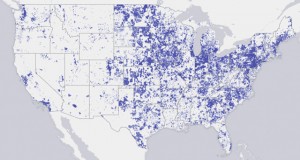As telecommunications policy expert Susan Crawford pointed out to Bill, over the past decade, America has fallen behind many other wealthy countries in access to high-speed Internet. The Organisation for Economic Co-operation and Development (OECD) recently ranked America 15th internationally, with broadband available to only 68.2 percent of households. Compare that with 87 percent in Iceland or 97.5 in Korea. Our slower Internet is also more expensive than in other parts of the world.
According to a report from the National Telecommunications and Information Administration (NTIA), a certain amount of America’s lack of high-speed Internet can be attributed to population density. America is far more spread out than, say, Korea, and faster connections are possible when the length of the wires from the phone company to your home is shorter. But that’s not the full story — in Canada, a country far less dense than the US, 72.2 percent of households have broadband.

The National Broadband Map is a tool to search, analyze and map broadband availability across the United States. The colored portions of the map indicates Internet speed rates of at least 768 kbps.
Across America, access to high-speed Internet varies tremendously — even within a single community — an issue several federal communications commissioners have committed themselves to addressing.
Where does your community fall within the spectrum of connectivity? The National Broadband Map can tell you (click “Explore the Maps”).
Before exploring the data, you can test your own connection speed using the FCC’s quality test. The New York City-based Moyers & Company Web team gets about 10 mbps, if you’re interested.

